Knee replacement surgery has transformed the lives of millions, restoring mobility and relieving pain for patients suffering from severe arthritis or injury. However, with continuous advancements in medical technology, the landscape of knee replacement is evolving rapidly. Staying informed about these innovations can help patients make confident decisions, optimise their recovery, and ultimately enjoy better outcomes. This article explores the top knee replacement innovations every patient should know, offering insights into how modern techniques and technologies are reshaping this common yet critical procedure.
Understanding Knee Replacement Surgery
Before diving into the latest innovations, it is helpful to understand what knee replacement surgery entails. Simply put, the procedure involves removing damaged parts of the knee joint and replacing them with artificial components, known as implants. There are several types of knee replacement surgeries:
- Total Knee Replacement: Replacing the entire knee joint.
- Partial Knee Replacement: Only the damaged portion is replaced, preserving healthy parts.
- Revision Knee Replacement: A follow-up surgery performed when an initial knee implant fails or wears out.
Traditionally, knee replacements required large incisions and lengthy recovery times. However, modern surgical techniques and innovations—often recommended by the best orthopedic doctor in Ahmedabad—are changing this narrative, improving precision, comfort, and recovery speed.
Minimally Invasive Surgery (MIS)
One of the most significant advancements in knee replacement is the development of minimally invasive surgery (MIS) techniques. Unlike conventional procedures that involve large incisions and extensive tissue disruption, MIS uses smaller cuts to access the knee joint. This approach offers multiple benefits:
- Smaller incisions mean less tissue damage.
- Reduced pain and scarring.
- Faster healing and shorter hospital stays.
- Quicker return to daily activities.
Patients undergoing MIS can expect a smoother post-operative experience, with less discomfort and an accelerated rehabilitation process. This innovation has made knee replacement a more appealing option for many, especially those concerned about lengthy recovery.

Robotic-Assisted Knee Replacement
Robotic technology is revolutionising knee replacement by enhancing surgical precision. Robotic-assisted knee replacement allows surgeons to plan the procedure meticulously using advanced imaging and then execute the surgery with robotic guidance.
Key benefits of robotic-assisted surgery include:
- Extremely accurate implant positioning tailored to patient anatomy.
- Minimisation of human error during bone cutting and implant placement.
- Preservation of healthy bone and tissue for better function.
- Improved alignment, which is crucial for implant longevity and patient mobility.
This technology offers a promising leap forward in terms of long-term success, reducing revision surgery rates and improving patient satisfaction.
Customised and Patient-Specific Implants
Standard implants have served well for decades, but innovation is moving towards customised, patient-specific implants. By leveraging 3D printing technology and detailed imaging, surgeons can design implants that perfectly match a patient’s knee structure.
Advantages include:
- Superior fit, leading to more natural knee movement.
- Enhanced comfort and stability.
- Lower risk of implant loosening or wear.
- Potentially faster rehabilitation due to better biomechanics.
Custom implants represent a tailored approach to knee replacement, reflecting a shift towards personalised medicine that considers individual anatomical differences for optimal outcomes.
Advanced Implant Materials
The choice of implant material is crucial for the longevity and performance of a knee replacement. Recent innovations have introduced advanced materials that offer enhanced durability and biocompatibility.
Some notable materials include:
| Material | Benefits |
| Highly Cross-Linked Polyethylene | Greater wear resistance, reducing implant wear |
| Ceramic Composites | Biocompatible, lower risk of allergic reactions |
These materials not only extend the lifespan of the implant but also contribute to improved mobility and reduced inflammation, supporting a more active lifestyle post-surgery.
Enhanced Pain Management Techniques
Pain control after knee replacement is vital for successful recovery. Innovations in this area have made post-operative pain more manageable than ever.
Modern techniques include:
- Nerve blocks: Target specific nerves to numb the knee area during and after surgery.
- Regional anaesthesia: Reduces systemic side effects compared to general anaesthesia.
- Multimodal pain relief: Combining different medications and methods for better pain control.
These approaches minimise the need for opioids, reduce side effects, and enable patients to engage in early rehabilitation, accelerating their return to normal activities.
Improved Rehabilitation and Recovery Protocols
Advancements don’t stop in the operating theatre; rehabilitation is also evolving with new protocols designed to optimise recovery.
Key developments include:
- Early mobilisation: Encouraging patients to begin moving soon after surgery to prevent stiffness.
- Technology-driven rehab: Use of tele-rehabilitation platforms and wearable sensors to monitor progress remotely.
- Personalised physiotherapy: Tailored exercises based on patient-specific needs and recovery speed.
These innovations not only shorten hospital stays but also improve long-term joint function and patient satisfaction.
The Role of AI and Data Analytics
Artificial Intelligence (AI) and data analytics are beginning to influence knee replacement in exciting ways.
Examples include:
- AI-powered tools that assist surgeons in pre-operative planning by analysing vast amounts of patient data.
- Predictive models that estimate individual risk factors and likely outcomes, allowing for better-informed decisions.
- Data-driven refinement of surgical techniques and post-operative care protocols.
The integration of AI helps improve the accuracy and efficiency of knee replacement procedures, ultimately benefiting patients with personalised, evidence-based treatment plans.

Choosing the Right Surgeon for Your Knee Replacement
While innovations provide many benefits, the skill and experience of the surgeon remain paramount. Selecting the best knee replacement doctor in Ahmedabad or the best orthopedic doctor in Ahmedabad can significantly influence the success of your surgery.
Here are some tips for choosing the right surgeon:
- Verify credentials and specialisation in knee replacement surgery.
- Ask about experience with advanced techniques like robotic-assisted surgery and minimally invasive methods.
- Review patient feedback and success rates.
- Discuss the surgeon’s approach to personalised implants and pain management.
- Ensure they offer comprehensive rehabilitation support.
Choosing an expert who embraces modern innovations can maximise your chances of a smooth surgery and a speedy recovery.
Conclusion
The field of knee replacement surgery is undergoing remarkable advancements, offering patients safer procedures, better implant materials, personalised solutions, and faster recovery than ever before. From minimally invasive techniques and robotic assistance to AI-driven planning and improved rehabilitation, these innovations are transforming patient experiences and outcomes.
For anyone considering knee replacement, staying informed about these developments is key to making confident decisions. Equally important is choosing the right specialist — the best knee replacement doctor in Ahmedabad or the best orthopedic doctor in Ahmedabad — who can tailor the treatment to your unique needs.
If you seek expert care that combines cutting-edge innovation with compassionate treatment, Dr Meet Mehta is a trusted name in knee replacement. By partnering with a knowledgeable specialist, you can look forward to a future of improved mobility and renewed quality of life.


